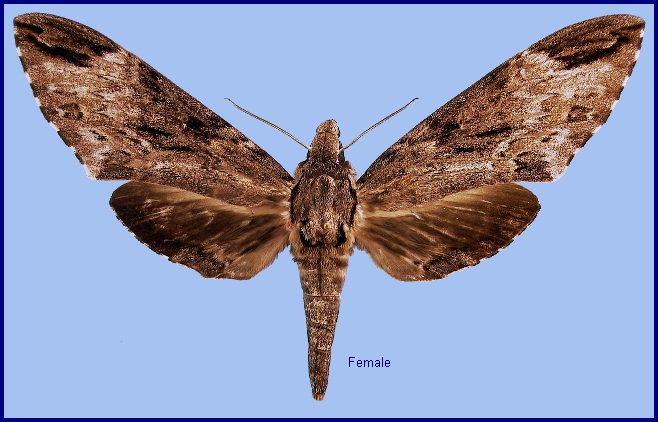
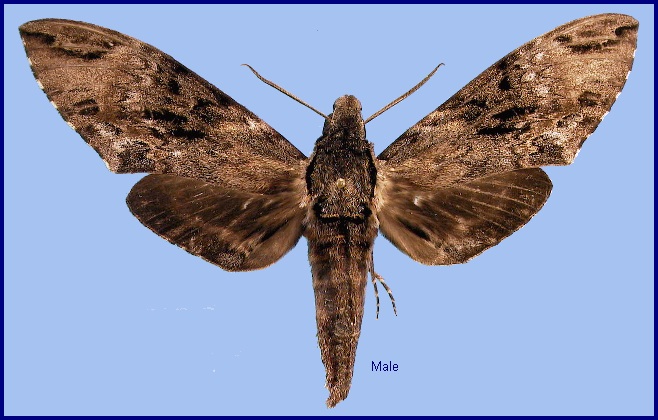
Macrosila discistriga Walker, 1856. List of the Specimens of Lepidopterous Insects in the Collection of the British Museum. Sphingidae. 8: 209. Type locality: [Bangladesh,] Silhet [Sylhet].
Synonym. Macrosila discistriga Walker, 1856.
Synonym. Macrosila darius Ménétriés, 1857.
Synonym. Sphinx emarginata Moore, 1858.
Synonym. Macrosila discistriga Walker, [1865].
Synonym. Diludia melanomera Butler, 1875.
Synonym. Diludia macromera Butler, 1882.
Synonym. Psilogramma (menephron) increta f. eburnea Closs, 1911.
Synonym. Psilogramma choui Eitschberger, 2001.
Synonym. Psilogramma danneri Eitschberger, 2001.
Synonym. Psilogramma discistriga medicieloi Eitschberger, 2001.
Synonym. Psilogramma discistriga paukstadtorum Eitschberger, 2001.
Synonym. Psilogramma hainanensis Eitschberger, 2001.
Synonym. Psilogramma hauensteini Eitschberger, 2001.
Synonym. Psilogramma stameri Eitschberger, 2001.
Synonym. Psilogramma stameri chuai Eitschberger, 2001.
Synonym. Psilogramma surholti Eitschberger, 2001.
Synonym. Psilogramma discistriga hayati Eitschberger, 2004.
Note. Lectotype designated by Kitching & Cadiou (2000), Hawkmoths of the World: 160.
Note. Synonymized with Psilogramma menephron menephron by Rothschild & Jordan (1903), Novit. zool. 9 (suppl.): 42. Incorrectly synonymized with Psilogramma melanomera by Eitschberger (2001), Neue ent. Nachr. 52: 6. Reinstated as a species by Eitschberger (2010), Neue ent. Nachr. 64: 15.
Note. Up until recently included within the Psilogramma menephron (Cramer, 1780) complex of species.
Wingspan: 82--138mm. Variable in colour and size, individually as well as geographically; in most localities there is a dark and a pale form. There are three principal forms of this subspecies: a pale form; a pale form with a conspicuous black medio-costal area on the forewing upperside; and a dark form. Mesonotum sometimes with two black dots. Foretarsal segments 2-5 often dark brown. The underside of the abdomen is usually brownish in this species and pure white in the similar Psilogramma increta (Walker).
In the male genitalia, uncus divided into two slender, curved processes that are close together, but are moveable separately. Gnathos short and broad, the lobe broader than long, truncate-sinuate, the angles slightly produced, the sides distally rounded/dilated. Valve with a patch of stridulatory scales about 3x as long as broad, deep brown except at edges. Phallus with process very characteristic, sometimes distinctly asymmetrical. In the female genitalia, postostial part of ostial plate sclerotised, smooth, scaled, half-moon shaped, somewhat truncate, the lateral margins elevated. Ostial cavity surrounded proximally and laterally by a wrinkled membranous ridge.
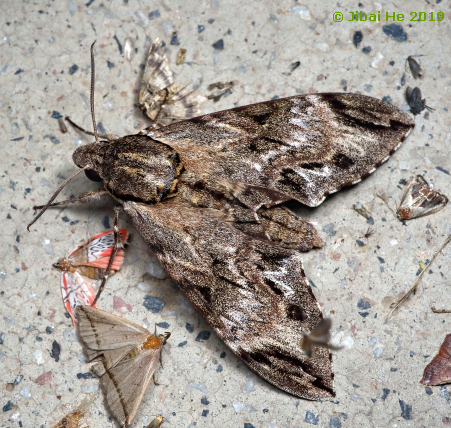
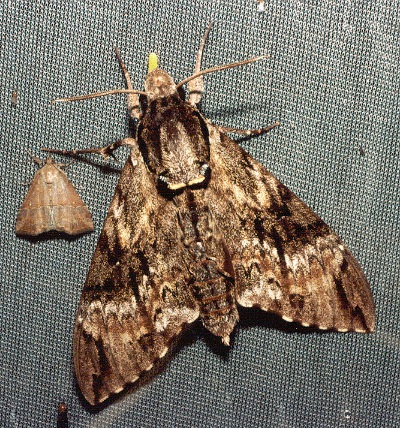
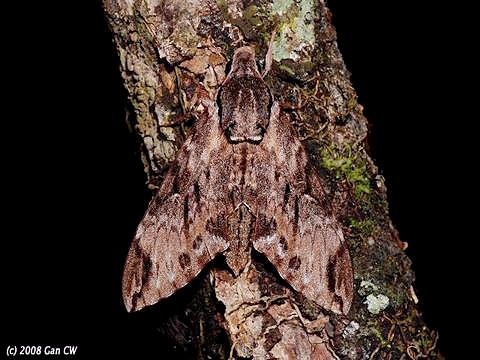
Habits of the imago similar to those of the genus Acherontia, i.e. when disturbed it raises the front part of the body and wings and sometimes makes a clicking noise similar to that made by the larva; flight rapid. Frequently comes to light, and may often be caught feeding at tubular flowers after dusk (Bell & Scott, 1937).
In Metro-Manila, the Philippines, this synanthropic species is more common in suburban parks, gardens and along roadside plantings than in rural areas (Dvořák, 2014).
China: v (Hong Kong; Hubei); vi (Yunnan; Guizhou; Xizang/Tibet); vii (Hong Kong); ix (Hong Kong).
OVUM: Pale green, slightly oval (1.60 x 1.40mm), surface smooth and shiny. The eggs are laid singly on a number of hostplants (Bell & Scott, 1937).
LARVA: Full-fed 90--110mm, horn about 12 mm. According to Bell & Scott (1937), in the final instar head round, slightly longer than broad, vertex rounded; true clypeus one-third to one-half length of head, basal angles rounded and slightly tumid; labrum three-quarters length of clypeus; ligula as long as labrum, shaped like a bent sausage. Surface of head smooth and shiny. Body nearly cylindrical, tapering slightly from segment 5 frontad. Horn long, straight or slightly down-curved, stout at base and tapering evenly to a blunt point. Surface of body smooth and dull; on segments 2 to 4 transverse rows of large, shiny, rounded tubercles, two rows each on 2 and 3, one row on 4, each row running along a secondary ring over the dorsum, about eight tubercles in each row; horn shiny and covered with large, shiny tubercles.
Head grass-green; a white stripe running down the cheek from near vertex to base of antenna; labrum and ligula opaque white, sinus of ligula bordered rusty-red; basal and second segment of antenna pale yellow, third segment pale dusty-red; mandible pale yellow, outer face pale rusty, tip broadly reddish-brown. Segments 2 to 4 of body bluish-green, the tubercles white or yellow, rest of body bright grass-green in dorsal area, paler bluish-green in lateral area. There is a narrow whitish dorsal stripe from 5 to base of horn, and seven broad white oblique lateral stripes on 5 to 11, the upper edge sharply and bordered with dark green, the lower edge ill-defined. Each stripe runs back to join the dorsal stripe on the adjoining segment, that on 11 running back to base of horn. Horn green with paler tubercles. True legs pale yellow with the end segment rust-coloured; prolegs and claspers green; tubercles on anal flap and claspers black. Spiracles oval, flush, white with a central black slit, the whole ringed narrowly with green. Some individuals develop irregular patches of lilac or brown above the oblique stripes, and these sometimes extend to the dorsum on some of the segments to the anal flap, claspers and venter.
The habits of the larva are similar to those of moths of the genus Acherontia; it is sluggish, resting by day and feeding by night, the resting position being the characteristic sphinx-like attitude of raising the front part of the body from the surface, bowing the head and bunching the fore legs together. When molested it strikes sideways with the head and makes a clicking noise. The larva moults four times. Pupation in a cell underground (Bell & Scott, 1937).
In Metro-Manila, the Philippines, larvae of this synanthropic species are common in suburban parks, gardens and along roadside plantings, more so than in rural areas (Dvořák, 2014).
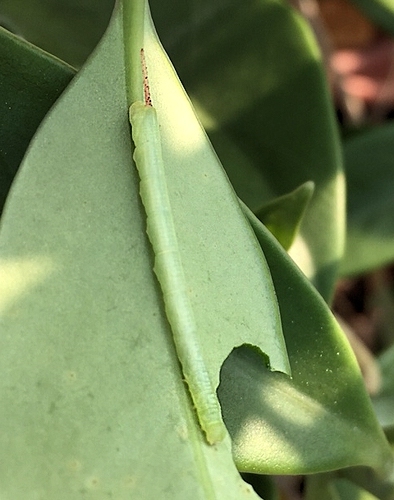
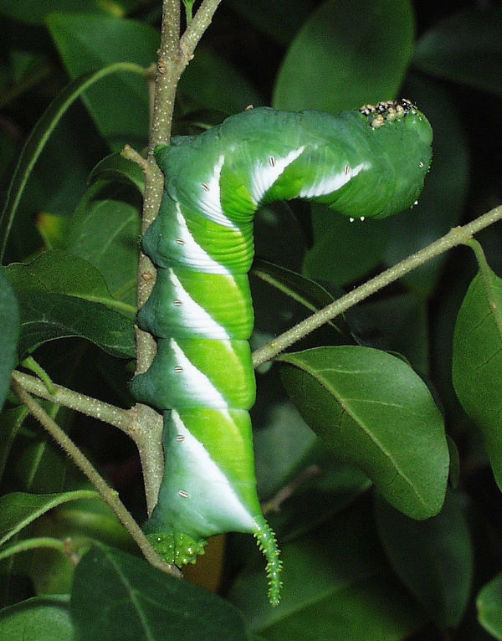
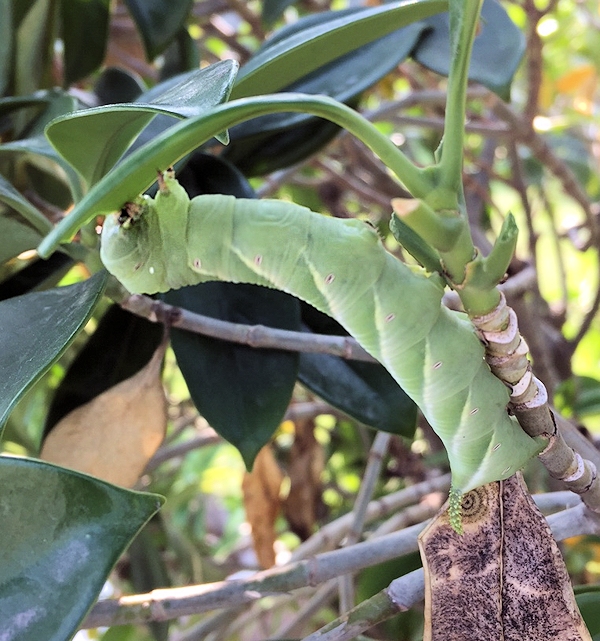
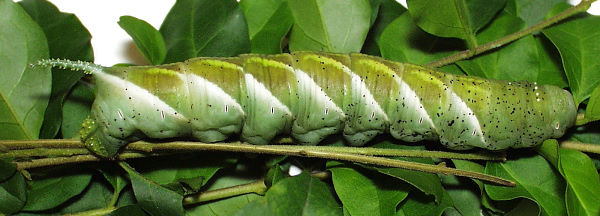
PUPA: 48--60mm. Colour chestnut under the bluish bloom; spiracles the same with black central slits; cremaster black. Tongue reaching to tip of wing-case; tongue-case free, a cylindrical tube with bulbous end, shaped like the handle of a jug, starting from the frons in a line at right angles to the axis of the body, then curving backwards in an arc or semicircle, the bulbous end touching the venter of the pupa at the middle of the wing-case, where it often forms a depression in the surface, though remaining free. Antenna shorter than fore leg in both sexes; coxal piece present. Surface smooth and shiny, covered with a bluish plum-like bloom; eye-crescent black, shiny and depressed; the head and thorax minutely wrinkled. Sculpturing on segment 4 in the form of a subdorsal, flat, oblong weal, slightly raised, black and shiny with a median channel; there are ante-spiracular ridges on 9 to 11, four ridges on each. The spiracle of 2 indicated by a raised, black, oval spot, those on the other segments oval and lying on a larger oval depression. Cremaster triangular, flattened dorsally and laterally, the edges of the dorsal surface raised into a ridge, leaving a median channel; the dorsal surface rugose, the ventral surface shallowly hollow with a slight median keel and raised edges; the truncate tip ends in two slightly converging teeth (Bell & Scott, 1937).
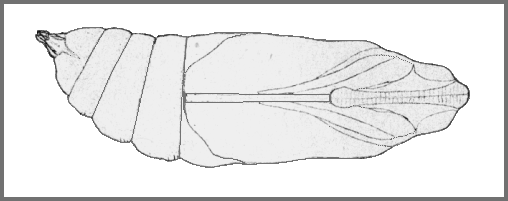
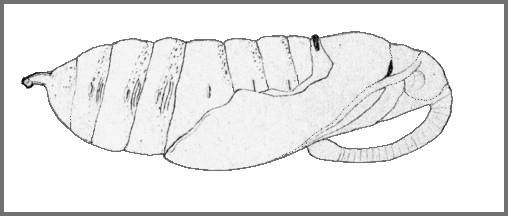
Larval hostplants. In Hong Kong on Clerodendrum fortunatum (Verbenaceae) and Ligustrum sinense (Oleaceae) (Tennent, 1992; David L. Mohn, pers. comm. 2005). Li & Guo (1990) give Ligustrum and Fraxinus for Shanxi. Dvořák (2014) lists Spathodea campanulata and Fagraea ceilanica for Guangzhou; the latter was also recorded by Danny Kruger (pers. comm. 2016). Recorded from Melia azedarach and Paulownia fortunei in Macau (Easton & Pun, 1996).
In Metro-Manila, the Philippines, common in suburban parks, gardens and along roadside plantings on the African ornamental tree Spathodea campanulata, particularly on the more mature trees (Dvořák, 2014).
In India on Jasminum, Ligustrum, Tectona grandis, Vitex negundo, Callicarpa arborea and others (Scott, 1941). Dvořák (2014) even lists Cananga odorata (Annonaceae) for Metro-Manila, the Philippines.
Elsewhere from many other genera, including Lonicera, Perilla, Osmanthus Sesamum (Inoue, Kennett & Kitching, [1996] 1997).
Tachinidae: Compsilura concinnata (Meigen, 1824).
China: Shanxi (Taiyuan; Taigu); Anhui (Mt. Huang Shan); Hubei (Wuhan); Yunnan (nr. Lüchun, Huanglian Nature Reserve, 1900m); Xizang/Tibet (Gamtog); Guizhou (Shiqian, 700m; Fanjingshan, Tongren County); Hunan; Fujian (Longqi Shan); Guangdong; Macau; Hong Kong (North Point); Guangxi (Nanning); Hainan.
Northern India (Subhasish Arandhara, 2016; Jatishwor Irungbam & Fric, 2021; Sondhi, Karmakar, Sondhi & Kunte, 2021; Chakraborty, Chakraborty, Biswas, Chakraborty & Deb, 2024), Nepal, Bhutan (Irungbam & Irungbam, 2019), Myanmar/Burma, Great Nicobar Island (Singh, Ahmad & Chandra, 2021), central and southern China, Vietnam (Le & Vu, 2024), Laos, Thailand, Malaysia, Indonesia and the Philippines.
[The introduced populations on Guam and Hawaii have now been confirmed as being Psilogramma increta (Walker, [1856]), not Psilogramma menephron -- Psilogramma discistriga as originally suspected (Austin & Rubinoff, 2022).]
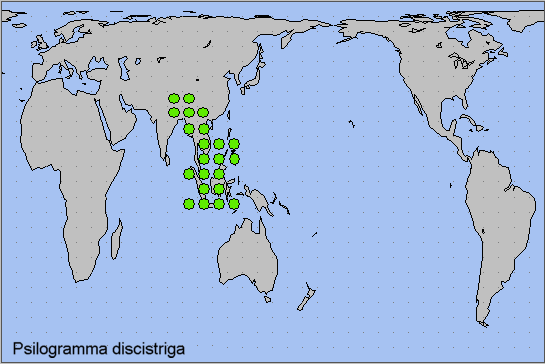
 Return to Sphingidae of the Eastern Palaearctic species list
Return to Sphingidae of the Eastern Palaearctic species list